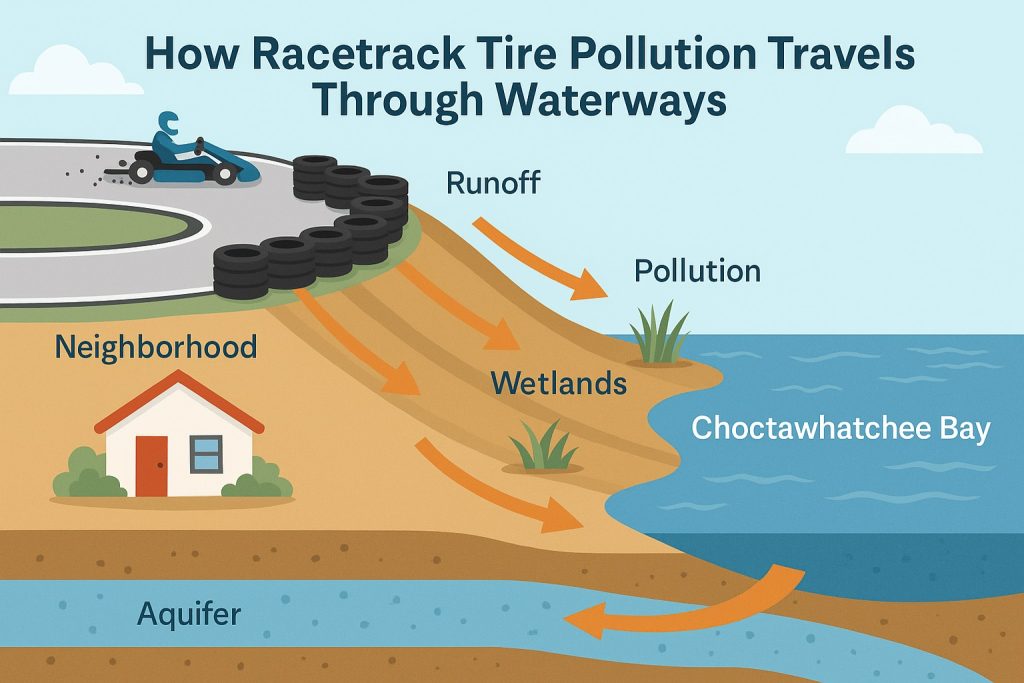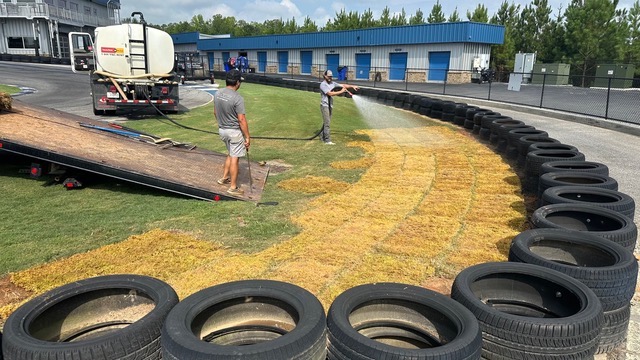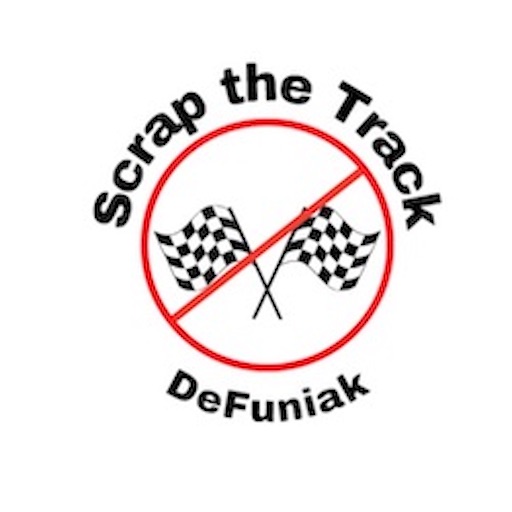
EPA Study Warns: Racetrack Tire Pollution Could Threaten Choctawhatchee Bay
The proposed Emerald Coast Motor Club (ECMC) in Walton County is being promoted as a private luxury racetrack club featuring a 3.5-mile FIA-grade track, a professional karting circuit, a skid pad, and trackside facilities. But a recent Environmental Protection Agency (EPA) study raises serious concerns about potential environmental risks tied to tire pollution.
According to EPA researchers, rubber tires release a “cocktail of toxic chemicals, heavy metals, and microplastics” when they wear down or degrade. Given the racetrack’s proximity to sensitive waterways and wetlands, these pollutants could enter Blount’s Creek, Alaqua Creek, and ultimately the Choctawhatchee Bay watershed.
County Policy Already Recognizes Tire Toxicity
Under Walton County Comprehensive Plan Policy I-3.1.4, waste tires are prohibited from disposal in county landfills due to their toxicity. Instead, the county mandates special handling and recycling in compliance with Florida Department of Environmental Protection (DEP) regulations.
“Walton County’s own plan bans waste tires from landfills due to toxicity — yet this project could place thousands of degrading tires above wetlands, creeks, and our aquifer.”
At other racetracks within the same club organization as ECMC, it’s common practice to use discarded tires as safety barriers along high-speed curves, impact zones, and especially around karting tracks. If a similar approach is used here, thousands of used tires could be stacked on-site, left to degrade under Florida’s heat and heavy rainfall.
If tires are considered too hazardous for county landfills, the potential environmental consequences of concentrating thousands of them directly above wetlands, creeks, and the aquifer make a full, independent environmental review essential.
EPA Research on Tire Pollution Risks
The EPA’s findings indicate that tire wear particles (TWPs) are a major source of microplastic pollution and may carry chemicals harmful to aquatic ecosystems and drinking water supplies.
Key findings include:
Tire wear particles may account for up to 85% of microplastics in urban stormwater runoff.
These particles can contain heavy metals, synthetic rubbers, and chemical additives. One chemical in particular, 6PPD, transforms into 6PPD-quinone, a compound the EPA has linked to fish mortality at very low concentrations.
Pollutants from degrading tires have the potential to migrate into soil, surface waters, and groundwater, where they may persist for decades.
Why the ECMC Site Could Be Especially Vulnerable
The location, design, and topography of the ECMC site create multiple pathways for potential contamination:
120-foot slope from north to south
Runoff from the racetrack, skid pad, and karting track could flow downhill into nearby neighborhoods and private properties.
Proximity to Blount’s Creek
The professional karting track is planned within 900 feet of Blount’s Creek, a sensitive tributary that feeds directly into the Choctawhatchee Bay watershed.
Downhill wetlands within 1,000 feet
These wetlands serve as natural filters but may be unable to handle sustained chemical runoff without degradation.
Connection to the aquifer
Pollutants from tire particles and runoff could infiltrate groundwater, impacting drinking water quality for surrounding areas.
How Racetrack Design Could Intensify the Problem

This isn’t just about tires wearing down during races. It’s also about how racetracks are built and operated:
1. Tire Barriers as Potential Chemical Sources
Professional racetracks and karting circuits often stack discarded tires as safety barriers along curves and impact zones — and this is especially common in other racetracks operated by ECMC’s club organization. Over time, these tires bake in the sun, collect rainfall, and break down, releasing a cocktail of chemicals that could leach into surrounding soils and waterways.
2. Sprinkler Systems Could Accelerate Runoff
The ECMC karting track plans to use a sprinkler system for wet-weather driving, a common practice in professional karting. However, this system could increase the volume and speed of runoff, carrying tire particles and chemicals more rapidly into Blount’s Creek, Alaqua Creek, wetlands, and the Choctawhatchee Bay watershed.
3. Skid Pads May Generate Excessive Tire Debris
The planned professional skid pad encourages tire-slipping maneuvers that produce far more rubber particles than normal road driving. Given the property’s slope, this could accelerate the transfer of pollutants into sensitive nearby ecosystems.
How Racetrack Tire Pollution Could Affect the Choctawhatchee Bay Watershed
The ECMC site sits within the Choctawhatchee Bay watershed, meaning any pollutants released on-site could travel far beyond the immediate area. According to EPA findings, tire-related contaminants have the potential to:
Reach Blount’s Creek and Alaqua Creek tributaries
Impact aquatic life and fish species sensitive to 6PPD-quinone toxicity
Alter delicate wetland ecosystems
Threaten the long-term health of the Choctawhatchee Bay, which supports local tourism, recreation, and commercial fisheries
This Is About More Than Noise
While much of the discussion around ECMC has centered on noise impacts, the potential chemical pollution raises equally serious concerns.
Once tire-derived chemicals and microplastics enter creeks, wetlands, aquifers, and bays, they cannot be removed. Without proactive assessment and mitigation, Walton County could face lasting environmental and economic consequences.
What Needs to Happen Next
Before this project moves forward, Walton County should:
Require a full, independent environmental impact study
Assess potential runoff impacts on Blount’s Creek, Alaqua Creek, and downstream wetlands
Evaluate possible risks of aquifer contamination from tire wear particles and leaching
Ensure public transparency regarding effects on the Choctawhatchee Bay watershed
Our creeks, wetlands, and bay define Walton County.
A project of this scale could carry serious risks for our waterways, wildlife, and drinking water. Before any approvals, these potential impacts must be fully understood.
Sources
Disclaimer
This article discusses potential environmental impacts based on EPA research and case studies. It does not assert that pollution will occur but highlights possible risks that warrant further evaluation.
FAQs: Racetrack Tire Pollution and the Choctawhatchee Bay Watershed
1. Could racetrack tire pollution affect the Choctawhatchee Bay watershed?
Yes, according to EPA research, rubber tires release a “cocktail of chemicals, heavy metals, and microplastics” when they wear down or degrade. If a racetrack is located near wetlands, creeks, or tributaries connected to the Choctawhatchee Bay watershed, these contaminants could enter local waterways through runoff, potentially impacting water quality and aquatic ecosystems.
2. What chemicals in tires pose risks to waterways and wildlife?
EPA studies indicate that tire wear particles (TWPs) often contain heavy metals, synthetic rubbers, and additives like 6PPD, which transforms into 6PPD-quinone. This compound has been shown to be highly toxic to certain fish species at very low concentrations. These chemicals may also persist in soils and groundwater, raising concerns for both wildlife and drinking water sources.
3. How could racetrack design increase the risk of pollution?
Professional racetracks and karting circuits often use stacked tire barriers, skid pads, and even sprinkler systems for wet-weather driving. EPA findings suggest that these conditions can accelerate tire breakdown and increase polluted runoff. When racetracks are built near creeks, wetlands, or aquifers—as in Walton County—the potential for contamination rises significantly.
4. Why is Walton County’s Policy I-3.1.4 relevant to this issue?
Walton County Comprehensive Plan Policy I-3.1.4 explicitly prohibits waste tires from being disposed of in county landfills due to their toxicity. The county requires special collection and recycling in compliance with Florida Department of Environmental Protection (DEP) rules. If waste tires are considered too hazardous for landfills, concentrating thousands of degrading tires on a racetrack could introduce environmental risks that align with the county’s own concerns.
5. How can racetrack tire particles impact local drinking water?
EPA research shows that tire particles and their chemical additives can migrate through soils and into groundwater aquifers. Given the proposed racetrack site’s 120-foot slope and proximity to Blount’s Creek, wetlands, and tributaries feeding the Choctawhatchee Bay, pollutants could potentially infiltrate groundwater sources, raising concerns for drinking water quality in nearby neighborhoods.
